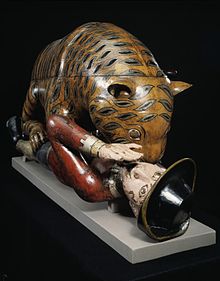
Back Tigre Tipu Catalan Tipu's Tiger Welsh Tipu's Tiger Danish Tipus Tiger German Ο Τίγρης του Τίπου Greek Tigre Tipu Spanish Tigre de Tippu French टीपू का बाघ Hindi Tigre di Tippu Italian ಟಿಪ್ಪುವಿನ ಹುಲಿ Kannada

Tipu's Tiger or Tippu's Tiger is an 18th-century automaton created for Tipu Sultan, the ruler of the Kingdom of Mysore (present day Karnataka) in India. The carved and painted wood casing represents a tiger mauling a near life-size European man. Mechanisms inside the tiger and the man's body make one hand of the man move, emit a wailing sound from his mouth and grunts from the tiger. In addition a flap on the side of the tiger folds down to reveal the keyboard of a small pipe organ with 18 notes.[1]
The automaton incorporates Tipu's emblem, the tiger, and expresses his hatred of his enemy, the British of the East India Company. It was taken from his summer palace when East India Company troops stormed Tipu's capital in 1799. The Governor General, Lord Mornington, sent the tiger to Britain initially intending it to be an exhibit in the Tower of London. First exhibited to the London public in 1808 in East India House, then the offices of the East India Company in London, it was transferred to the Victoria and Albert Museum in 1880.[2] It now forms part of the permanent exhibit on the "Imperial courts of South India".[3] From the moment it arrived in London to the present day, Tipu's Tiger has been a popular attraction to the public.
- ^ "Tippoo's Tiger – European Romanticisms in Association". 9 August 2019.
- ^ Victoria & Albert Museum (2011). "Tipu's Tiger". London: Victoria & Albert Museum. Retrieved 16 July 2011.
- ^ Ivan; Corinne A. (2000). "Reflections on the fate of Tippoo's Tiger - Defining cultures through public display". In Hallam, Elizabeth (ed.). Cultural encounters: representing otherness. Street, Brian V. Routledge. p. 194. ISBN 978-0-415-20280-0.[permanent dead link]
© MMXXIII Rich X Search. We shall prevail. All rights reserved. Rich X Search